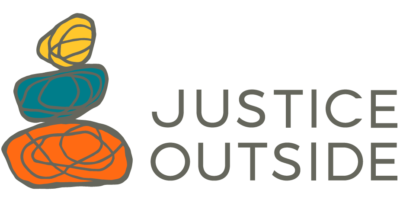As environmental justice advocates, our work within 30×30 is to ensure that Indigenous people and communities of color are truly at the center of the 30×30 work plan, designing solutions, prioritizing efforts, and redressing historic harms, using their knowledge and expertise, joy, and creativity to inform the work.² It’s clear that we cannot bring about greater social justice, ensure greater health outcomes for generations to come, and tackle the climate and nature crises without leadership that is culturally relevant and committed to the well-being of people of color.
Given the transformational potential of this moment, Justice Outside has joined in coalition with other groups focused on social justice and equitable decision-making and funding for the outdoors and our environment. Our coalition with Parks Now lays out the principles informing our values-driven approach to 30×30:
- People in every community caring for nature is the best guarantee for sustainable biodiversity.
- Access to nature is fundamental to people’s health and is a right that must be guaranteed for all.
- Equitable access to nature means more than removing physical barriers; it is also about creating spaces that are safe and welcoming to all.
- Local communities—including Tribal governments and other Black and Indigenous communities and communities of color—hold important lived experiences and knowledge critical to caring for nature and identifying priority areas for conservation and restoration.
- Protection of nature and outdoor recreation can take many different forms, depending on regions, cultural traditions, and other factors.
Our Parks Now coalition further calls upon agencies to plan for and invest in biodiversity protection and equitable public access as twin branches of the same tree. It is not enough to conduct surveys and hold community meetings—we must evolve our approaches and go beyond “checking the box” of gaining community input. Rather, we must understand that to preserve biodiversity and protect communities and nature, we must ensure that 30×30 priorities, approaches, and local work plans are informed and led by communities of color.
Given the stated commitment to social and environmental justice in the federal 30×30 work plan, Justice Outside recognizes this as a moment of catalytic, hopeful necessity. Together we can transform the work of land and water protection and stewardship into the very tools that will help us dismantle systems of oppression and build the resilient future we all want.
²A similar but separate whole-of-government plan, Justice40, commits federal agencies to collaboration in order to deliver 40% of the overall benefits of federal climate, clean energy, affordable and sustainable housing, clean water, and other investments to “disadvantaged communities” that have been “historically marginalized, underserved, and overburdened by pollution.”
This blog is part of a series by Justice Outside exploring Indigenous and racial justice inside 30×30. 30×30 is a U.S. and global initiative to protect 30% of our lands and waters by 2030. Justice Outside’s commitment within 30×30 is to ensure that the leadership and voices of Black, Indigenous, and communities of color are at the center of our shared efforts to protect and conserve lands and waters.
View the series:
1] What is 30×30?
2] Why Black, Indigenous, and Communities of Color Should Be At the Center of 30×30 Conservation Efforts
3] The Role of Indigenous, Racial Justice, and Environmental Justice Groups in the U.S. Federal 30×30 Work Plan
4] What Are the Roles of Justice Outside and Other Environmental Justice Groups in 30×30?
5] What’s Next for 30×30 in the U.S.?
#30×30

